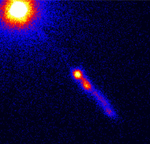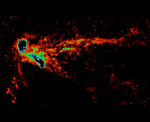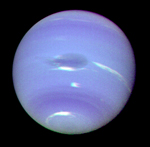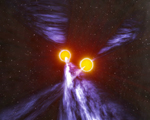Science from the Parkes telescope
Below is some of the most notable work done with the Parkes
telescope over the last four decades. The years given are those in which
the observations were made, unless otherwise noted.
- 1962
-
Parkes is used
for the first time to receive signals from a space mission, Mariner II. - 1962
-
Researchers using
Parkes find that our Galaxy has a magnetic field, a million times weaker
than Earth’s. - 1963 [publication date]
-
 An X-ray image of quasar 3C 273 and the jet emerging
An X-ray image of quasar 3C 273 and the jet emerging
from it. Credit: NASA/CXCAstronomers use Parkes to determine the position of quasar 3C 273, helping
to establish that quasars are extragalactic objects. - 1962
-
Astronomers using
Parkes find strong linear polarisation in the radio emission from the
galaxy Centaurus A. This indicates which process is producing the emission. - 1964
-
Publication of the
first results of Parkes’ first survey to find and catalogue cosmic
radio sources. - 1968
-
Astronomers using
Parkes detect pulsar signals, just weeks after UK researchers announce the
discovery of pulsars. - 1969
-
Parkes maps the Galaxy.
Work in the ’50s had shown that the Galaxy has spiral arms. Parkes
helped refine the picture by mapping the Galaxy’s main constituent,
neutral (that is, unionised) hydrogen gas. Two Parkes surveys published
in 1969 were combined with data from the Northern Hemisphere to give a new
picture of the distribution and motion of neutral hydrogen gas in the Galaxy. - 1969
-
Parkes’ first
observations using the technique of Very Long Baseline Interferometry (VLBI).
Parkes worked with telescopes at Owens Valley, California. - 1969
-
Parkes
receives television signals from the Apollo 11 Moon landing and relays
them to a worldwide audience of 600 million. - 1971
-
Parkes discovers its
first interstellar molecule, HCHS (thioformaldehyde). This is the first
interstellar molecule discovered by a group outside the USA. Parkes goes
on to discover several other molecules in space. - 1971
-
Parkes starts a new
survey at a frequency of 2.7 GHz, which finds many unusual new quasars. - 1972
-
Parkes is used in
the first general Southern Hemisphere VLBI (Very
Long Baseline Inteferometry) experiment. - 1973
-
 A recent image made with the Parkes telescope of the
A recent image made with the Parkes telescope of the
Large and Small MagellanicClouds, and the stream of gas flowing from them
– the Magellanic Stream.The Large Magellanic Cloud is the blue mass
towards the upper left; the Small Cloud is below, to the right.Parkes discovers
the Magellanic Stream, a long trail of hydrogen gas flowing from two small
neighbouring galaxies called the Large and Small Magellanic Clouds. - 1970s
-
Parkes is a receiving station
for NASA's Apollo 12, 14, 15 and 17 missions, and is called in to help during
the Apollo 13 emergency. - 1982
-
A quasar called PKS 2000-330,
an object in the Parkes radio catalogue, was found to have a redshift of
3.78, making it the most distant object in the Universe then known. - 1982
-
Parkes is used in the first VLBI
(Very
Long Baseline Interferometry) imaging experiment. - 1982
-
Parkes finds the first pulsar
outside our Galaxy, in the small neighbouring galaxy called the Large Magellanic
Cloud. - 1986
-
 The Voyager II spacecraft. Image: JPL
The Voyager II spacecraft. Image: JPLParkes receives signals from
NASA’s Voyager II spacecraft as it flies past Uranus. - 1986
-
 Comet Halley.
Comet Halley.
Credit: Mount Wilson ObservatoryParkes receives signals from
ESA’s Giotto spacecraft as it encounters Comet Halley. - 1989
-
 Neptune, imaged by Voyager II. Credit: JPL/NASA
Neptune, imaged by Voyager II. Credit: JPL/NASAParkes receives signals from
NASA’s Voyager II spacecraft as it flies past Neptune. - 1991
-
Parkes finds ten millisecond (very
fast) pulsars in 47 Tucanae, a globular cluster (a ball of about a million
stars on the outskirts of our Galaxy). The discovery doubles the known number
of these exotic objects. - 1991 [publication]
-
 The radio Einstein Ring PKS 1830-211
The radio Einstein Ring PKS 1830-211A network of
telescopes including Parkes identifies and images the strongest known
radio Einstein Ring, PKS 1830-211. Follow-up observations in 1995 show
the ring to be an extremely unusual object: a compound gravitational
lens, with two foreground objects at different distances.The ring includes two distinct images of the core of the background quasar:
the light paths giving rise to these differ in length. In 1998 the time
delay between the two light curves was used
to calculate the Hubble constant. The value given by this method is
independent of the estimates based on distance measurements. - 1994
-
Parkes observes the close encounter
of pulsar
B1259-63 and its companion star, SS2883. The encounter slowed the pulsar’s
pulse rate: this is the first time this effect, long predicted, had been
seen in a radio pulsar. - 1995
-
Researchers from the US-based
SETI Institute use Parkes for six months
to look at 200 nearby stars for signals from possible extraterrestrial civilisations.
This was the first phase of “Project Phoenix”, the biggest SETI
(search for extraterrestial intelligence) project up to that time. - 1996-1997
-
 Cloud bands on Jupiter, imaged by the Galileo spacecraft.
Cloud bands on Jupiter, imaged by the Galileo spacecraft.
Image: JPL/NASAParkes supports NASA by
receiving data from the Galileo spacecraft, sent to investigate Jupiter
and its moons, for 13 months. - 1997
-
Using the technique of VLBI (Very
Long Baseline Interferometry), a network of telescopes including Parkes
employs the Vela supernova remnant as a ‘magnifying glass’ to
image the Vela pulsar to an angular resolution of 10 nanoarcseconds. This
the first image of a pulsar’s radiosphere, and probably the highest-resolution
astronomical image ever made. - 1997
-
 The multibeam receiver system on the edge of the Parkes
The multibeam receiver system on the edge of the Parkes
telescope prior to installation. Photo: CSIROA
world-leading 'multibeam receiver system', which allows the telescope to
see 13 spots on the sky at once, is installed on the Parkes telescope.
The receiver system is used to survey the sky for neutral hydrogen gas–the
raw material from which stars are made. These surveys detect many galaxies
and gas clouds–some previously unknown–and produce the first
picture of the distribution of mass in the local universe that does not
rely, directly or indirectly, on the presence of stars. Findings made with
the multibeam receiver system include:- a new measure of how much 'ordinary' matter (baryons) there is in the
nearby Universe, and how galaxies rich in hydrogen are distributed in
our neighbourhood; - the distribution of the galaxies behind the Milky Way. These galaxies were
hidden from optical (light) telescopes by the gas and dust of the Milky
Way, but radio waves can travel through the dust; - the
discovery of a ‘leading arm’ of neutral hydrogen gas that
streams out ahead of two small neighbouring galaxies, the Magellanic Clouds.
This discovery , which also settled a long-standing controversy about
the mechanism producing the Magellanic Stream, gas which trails behind
the Clouds; and - the
identification of high-velocity neutral hydrogen clouds as shards of satellite
galaxies rather than ‘missing’ clumps of dark matter predicted
by the ‘cold dark matter’ theory of galaxy formation. The
controversy over the identity of these 'high-velocity clouds' had run
for four decades.
- a new measure of how much 'ordinary' matter (baryons) there is in the
- 1998
-
A
team using Parkes finds the thousandth pulsar known to science. (Parkes
has found more pulsars than any other telescope.) - 1998-2003
-
The Southern Galactic Plane
Survey, being done with Parkes, produces a detailed picture of the Southern
Galactic Plane, leading to the identification of a
new spiral arm in our Galaxy. - 1999
-
Astronomers using Parkes find
the pulsar J2144-3933. This pulsar, which spins only once every eight seconds,
defied
existing theories on the upper limit for pulsar periods. - 2001
-
Astronomers using Parkes find
a radio pulsar with a companion at least 11 times the mass of the Sun–the
most massive pulsar companion known. The companion is probably a massive
late-type (red) star. - 2001
-
Astronomers using Parkes find
30 young, energetic pulsars that may be the counterparts of otherwise unidentified
gamma-ray sources in our Galaxy. - 2001
-
Parkes is used for an exquisitely
sensitive test
of Einstein’s general theory of relativity. - 2002
-
 An artist's impression of the millisecond pulsar J1740-5340
An artist's impression of the millisecond pulsar J1740-5340
and its bloated red companion star. The pulsar is shown in blue, emitting
two beams of radio waves. Image: European Space Agency and Francesco Ferraro
(Bologna Astronomical Observatory)Using the Hubble Space Telescope
and Parkes, astronomers find never-before-seen binary system: a
super-fast spinning pulsar whose gravity has deformed its companion star
into a giant red teardrop. We may be seeing the system in a fleeting
phase of its life - the point at which a new millisecond pulsar has just
been fully 'spun up' by its companion star. - 2003
-
 An artist's impression of the double pulsar system,
An artist's impression of the double pulsar system,
J0737-3039. Credit: John Rowe AnimationsAstronomers using Parkes discover
the first known double pulsar system. This leads them to revise
the rate at which neutron stars coalesce, placing it about six times higher
than previously thought. The higher rate improves the chances of gravity-wave
detectors detecting such events. The
pulsar system will also allow subtle tests of General Relativity and,
because one pulsar eclipses the other, give astrononmers the chance to
investigate a pulsar’s outer atmosphere.
